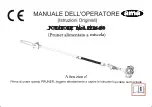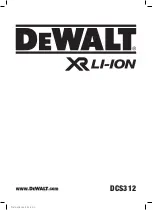
10 — English
STARTING/STOPPING THE SAW
See Figure 9, page 16.
To start the saw: Depress the switch trigger.
Always let the blade reach full speed, then guide the saw
into the workpiece.
WARNING:
The blade coming in contact with the workpiece
before it reaches full speed could cause the saw
to “kickback” towards you resulting in serious
injury.
To stop the saw: Release the switch trigger.
After you release the switch trigger, allow the blade to come
to a complete stop.
Do not remove the saw from the
workpiece while the blade is moving.
ADJUSTING BLADE DEPTH
See Figure 10, page 16.
Always keep correct blade depth setting. Less than a full tooth
of the blade teeth should be visible below the workpiece.
More blade depth will increase the chance of kickback and
cause the cut to be rough. For more depth of cut accuracy,
a scale is located on the depth bracket.
To adjust the blade depth:
Unplug the saw.
Pull depth lock lever upward to release.
Determine the desired depth of cut.
Hold base flat against the workpiece and raise or lower
saw until the index point or mark on the saw aligns with
the desired depth on the scale.
Push down on depth lock lever to lock into position.
INDEXING LEVERS
See Figure 11,
page 16
.
The levers on the saw can be repositioned for the best
tightening position.
Pull the lever out from the saw and move to desired
position.
Push lever back in and down to lock into place.
Check to be sure the base is clamped securely.
WARNING:
Attempting a bevel cut without having the bevel
lock lever securely locked in place can result in
serious injury.
OPERATION
OPERATING THE SAW
See Figures 12 - 14, pages 16 - 17.
It is important to understand the correct method for operating
the saw. Refer to the figures in this section to learn the correct
and incorrect ways for handling the saw.
WARNING:
To make sawing easier and safer, always maintain
proper control of the saw. Loss of control could
cause an accident resulting in possible serious
injury.
DANGER:
When lifting the saw from the workpiece, the blade
is exposed on the underside of the saw until the
lower blade guard closes. Make sure the lower
blade guard is closed before setting the saw down.
WARNING:
Use clamps or other practical way to secure
and support the workpiece to a stable platform.
Holding the work by hand or against your body is
unstable and may lead to loss of control which
could cause possible serious injury.
To make the best possible cut:
Hold the saw firmly with both hands.
Avoid placing your hand on the workpiece while making
a cut.
Support the workpiece so that the cut (kerf) is always to
your side.
Support the workpiece near the cut.
Clamp the workpiece securely so that the workpiece will
not move during the cut.
Always place the saw on the workpiece that is supported,
not the “cut off” piece.
Place the workpiece with the “good” side down.
Draw a guideline along the desired line of cut before
beginning the cut.
Keep the cord away from the cutting area. Always place
the cord to prevent it from hanging up on the workpiece
while making a cut.











































